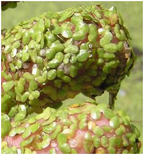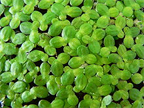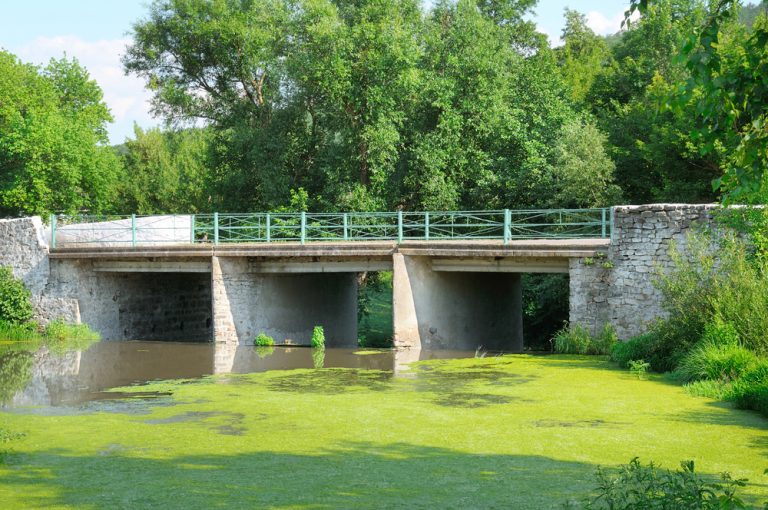Duckweed to Feed Tilapia in Aquaponics – The Food of the Future
– by Colle and Phyllis Davis
 Duckweed MAY be the food of the future. Grown under ideal conditions, duckweed ranges between 25% and 45% protein and doubles its growth every 36 hours, and OUR TILAPIA love to eat it along with their fish chow.
Duckweed MAY be the food of the future. Grown under ideal conditions, duckweed ranges between 25% and 45% protein and doubles its growth every 36 hours, and OUR TILAPIA love to eat it along with their fish chow.
We do not profess to be experts at growing farm-raised duckweed to feed our fish. In fact, quite the opposite is true. We have grown duckweed in kiddy-pools, large and small containers and even open-air tanks off-and-on for many years and we have not always been successful in our efforts to maintain our duckweed farms, but we keep trying and we continue to experiment to find the answers to pass along to you.
 Duckweed seems to overgrow in places that people do not want it to grow – like ponds, rivers and lakes, but it’s been difficult for us to raise it in tubs for more than a few weeks before it dies. If duckweed covers the surface of a body of water, there is an oxygen depletion which kills fish in the ponds, rivers or lakes. (Feed tilapia only enough for them to eat. The remnants are picked off over time.)
Duckweed seems to overgrow in places that people do not want it to grow – like ponds, rivers and lakes, but it’s been difficult for us to raise it in tubs for more than a few weeks before it dies. If duckweed covers the surface of a body of water, there is an oxygen depletion which kills fish in the ponds, rivers or lakes. (Feed tilapia only enough for them to eat. The remnants are picked off over time.)
Our latest experiments for growing duckweed suggests putting PVC pipes or PVC fittings in the water in the tanks for the duckweed to grow around it (which makes sense) so we’re going to try that and we’ll keep you posted.
If you plan to raise enough farm-raised duckweed to feed your fish for a commercial sized-farm, we recommend you speak with a local botanist in your area that might be able to guide you better than we can. There is a vast amount of scientific research and available information on the Internet about duckweed.

Image of duckweed growing near a bridge. If you look for areas near your own home with standing water, you may see your own ‘starter batch’ of duckweed.
Fun fact: People asked us for a long time what duckweed tasted like. One day our construction engineer said, “Well, I guess you ought to taste it so you can tell them.” So I did. It tastes like watercress. Tangy, peppery and very clean tasting. “Thought you’d like to know.” – Colle
Also, starch that comes from duckweed can quickly be changed into ethanol, which it can used instead of corn for ethanol. Farmers from large-scale hog farms, rid their waste through large duckweed lagoons.” It helps manage their animal wastes through biological treatment and can even ‘clean’ hog-waste water and makes the water potable by running the water through enough duckweed. Interesting, eh?
Here are a few links for you to study duckweed and its benefits and complexities:
http://www.fishfarming.com/duckweed.html
http://www.lrrd.org/lrrd7/1/3.htm
http://en.wikipedia.org/wiki/Lemna
http://www.mobot.org/jwcross/duckweed/Fish.htm
 Duckweed in kids 8′ kiddy pools
Duckweed in kids 8′ kiddy pools
In fact, here is a link to a technical working paper by researchers for the World Bank, Duckweed Aquaculture, A New Aquatic Farming System for Developing Countries, by Paul Skillicorn, William Spira and William Journey – Emena Technical Department, Agricultural Division.
Advice for ridding unwanted duckweed from ponds from the Royal Horticultural Society in London:
Non-chemical controls: Complete control is impossible and growth should be controlled before it reaches nuisance levels. Try the following for control and prevention of duckweed:
- On small ponds repeated raking or netting will keep the weed under control. Continuous removal is usually necessary
- On larger pools use a floating boom to sweep from end to end. Sweep at intervals from early in the season and continue until winter dormancy
- You can compost the removed weed
- Fit stop-boards at any upstream inlets to prevent duckweeds entering ponds or lakes
- Weed-eating water birds, such as domestic and ornamental ducks, moorhens and coots will provide some degree of control
- Grass carp will eat Lemna species
- Shading can reduce duckweed growth. This can be achieved by planting on the south side of the pond. Waterlilies and other plants with floating leaves can also substantially reduce the level of duckweed. The use of a fountain to disturb the surface may also help
14 comments
Skip to comment form
can catfish grow comfortably on duck weed?
Author
Yes, they will grow with duckweed they must be trained from ‘birth’to eat it. They prefer and fatten better with (floating) soy-based catfish food and will produce more effluent to fertilize the plants in the grow tables than just duckweed. We’ve never had great success with duckweed despite years and years of efforts.
Do catfish like to eat duckweed??
Author
James,
We have no direct experience with catfish eating duckweed so the answer lies in the omnivorous nature of catfish. They will eat almost anything.
Colle
does duckweed can be eaten by humans?
Author
Jeanne,
Yes. Duckweed is a used in parts of Africa and is being encouraged to be eaten in other places in the world. Please do some research on how specifically to raise it. I found it a wonderful watercress tangy addition to my life. The protein content is very high for plants.
Have fun.
Colle
Hi, am in Uganda-East Africa, where can i get the seeds and more information on duckweed in my country
Author
Tamale,
Every country has seed controls and most require buying from a government approved source within the country. These monopolies are incredibly destructive to innovation and new ideas. Luckily for you the duckweed grows everywhere.
Fun story: When we were in Lagos, Nigeria to complete a commercial installation for a hotel, we were told that they couldn’t find any duckweed to feed to their tilapia when they arrived. Each day as we were driven from the hotel to the job site and back we passed hundreds of meters of waterway and in most of them I could see duckweed growing and told our hosts to look there. They said it was algae and refused to stop.
On the third day the site manager came to me all excited and said he had indeed found some duckweed in his back yard, BUT he had forgotten to bring the sample with him that day. The next day he arrived with the sample and was astonished as he explained the previous morning he had take a small sample of the duckweed and placed it in a saucer of water so he could show it to the crew. This morning he looked in the saucer and discovered that the duckweed had doubled in one day to cover the entire surface of the water in the saucer. Tilapia feed sources was now guaranteed.
Duckweed grows everywhere and I guarantee that you will find a local source for free.
Good luck.
Colle
You said you tasted duckweed, how could it be used as a food source for humans?
Author
Chris,
It is used for human food. Type into a search engine ‘duckweed+humans’ and you will find hundreds of references. It has been used for centuries for human and animal consumption. Try it, you may like it.
Colle Davis – Inventor
I’m a student from Korea
I have one question!!!
I cultivated the duckweed to the experiment.
In this article, you cultivated duckweed by using small swimming pool.
but you don’t tell me about cultivate medium.
What do you use any medium to be cultivated?
Author
Jo,
We grew the duckweed in water with a small amount if fish waste water. Our luck with duckweed was not so good. We hope you had better luck.
Colle Davis – Inventor
I’ve found that innoculating my duckweed beds every month or so with a new batch seems to help with consistent cropping far into the fall. It likes a high nitrogen nutrient load, but don’t forget the micro nutrients. I’ll mix in a few pinches of unrefined sea salt in my kiddie pools. A little goes a long way. Great post. Duckweed is going to have its day in the sun within two years in this country because it’s got so much to offer.
Author
Tamra,
Thanks for the tip. That is one method we have not tried or even heard of before. When we set up our next duckweed pools we’ll see how that works and let everyone know of our success or non success. LOL
Love the duckweed information on your website. Keep up the great work. It’s so needed in today’s world.
Colle Davis, Inventor